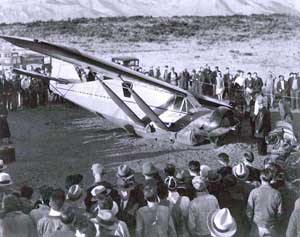On October 5, 1931, Clyde Pangborn (1894-1958) and Hugh Herndon Jr. land in Wenatchee, completing the first nonstop airplane flight between Japan and the United States. They are flying a Bellanca Skyrocket monoplane. The flight succeeds in part because Pangborn, a stunt aviator and test pilot, dropped the landing gear into the ocean shortly after takeoff in order to lighten the aircraft. In Wenatchee he successfully belly-lands the airplane, according to plan.
Upside-down Pang
Clyde Pangborn, born in Bridgeport (Douglas County), was a celebrity aviator during the early years of flight. He learned to fly in the U.S. Army during World War I, and after the war became one of the leading "barnstormers" -- aerial stuntmen and stuntwomen -- of the 1920s. Pangborn amazed crowds with daring deeds such as slow-rolling an airplane onto its back and flying upside down. But by the end of the 1920s, increasingly restrictive flight regulations began to put the aviation stunt shows out of business and Pangborn began looking for world records to break.
The first record he aspired to break was the speed record for flying around the world. Pangborn chose a friend and rather average pilot, Hugh Herndon Jr., as co-pilot to carry out this mission. Herndon was wealthy and able to finance the venture. When they began planning, the record was held by the German lighter-than-air airship Graf Zeppelin in 1929, with a time of 20 days, four hours. But in June 1931, a month before Pangborn and Herndon's takeoff, a new world record was achieved by Wiley Post and Harold Gatty, who flew around the world in 8 days, 15 hours, and 21 minutes.
Around the World
So Pangborn and Herndon set out to break this new record. They began their flight from Roosevelt Field, Long Island, New York, on July 28, 1931. They flew via northern Europe, Moscow, Siberia, and Japan. A mishap occurred when Herndon got lost over Mongolia while Pangborn was sleeping, and then in Siberia a rainstorm turned a runway into a mud sink. At this point the pilots realized they could not beat the Wiley Post record, so abandoned this effort.
They looked for an alternative world record to beat, and decided to fly between Japan and the United States, which had never been done in an airplane, although the Graf Zeppelin dirigible had completed the flight in 1929. Japan was offering a $25,000 prize for the first successful airplane flight. As Pangborn and Herndon flew over Japan, planning to land and begin their new attempt, Herndon photographed the countryside, including inadvertent shots of military installations. Upon landing, they were detained by the Japanese government, and it took the U.S. Embassy several weeks to obtain their release.
A Technical Adjustment
Finally they were liberated and prepared to fly across the Pacific. Pangborn decided that the aircraft was too heavy for the amount of fuel it could carry, so rigged up a gizmo that would jettison the landing gear after takeoff. He thought he could belly-land safely.
They took off from Japan on October 4, 1931, and over the Pacific dropped the landing gear into the ocean. However, two of the gear's struts stuck on, making a safe belly-landing impossible. Pangborn proceeded to crawl out on the wing to loosen the struts. The airplane was flying at 14,000 feet above the Pacific at 100 miles an hour in freezing weather. Out on the wing, Pangborn loosened the struts, dropped them into the ocean, and crawled back into the aircraft.
Mission Accomplished
Although they had intended to land in Spokane, they belly-landed in Wenatchee after a leg of 4,500 miles, in 41 hours and 13 minutes, completing the first airplane flight across the Pacific Ocean. (The time figures are provided by David H. Onkst, and vary slightly from source to source.)
Clyde Pangborn ended his career as a skilled test pilot. He spent World War II aiding the British in their fight against the Nazis. He died in 1958.

